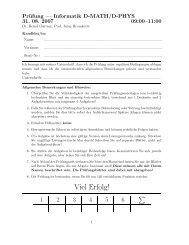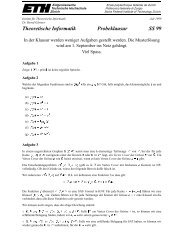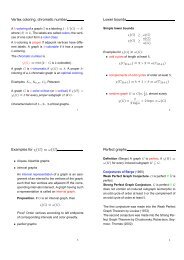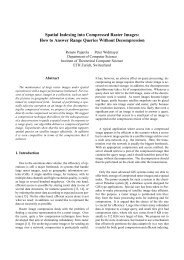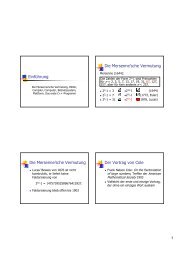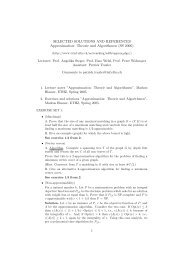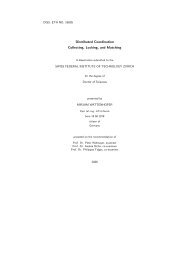Chapter 4 Line Sweep - TI
Chapter 4 Line Sweep - TI
Chapter 4 Line Sweep - TI
Create successful ePaper yourself
Turn your PDF publications into a flip-book with our unique Google optimized e-Paper software.
<strong>Chapter</strong> 4. <strong>Line</strong> <strong>Sweep</strong> CG 2012<br />
an eye on the size of the expressions that occur during an evaluation of such a predicate.<br />
In Exercise 3.22 we have seen that the orientation predicate can be computed by<br />
evaluating a polynomial of degree two in the input coordinates and, therefore, we say<br />
that<br />
Proposition 4.13 The rightturn/orientation predicate for three points inR 2 has algebraic<br />
degree two.<br />
The degree of a predicate depends on the algebraic expression used to evaluate it. Any<br />
such expression is intimately tied to the representation of the geometric objects used.<br />
Where not stated otherwise, we assume that geometric objects are represented as described<br />
in Section 1.2. So in the proposition above we assume that points are represented<br />
using Cartesian coordinates. The situation might be different, if, say, a polar<br />
representation is used instead.<br />
But even once a representation is agreed upon, there is no obvious correspondence<br />
to an algebraic expression that describes a given predicate. There are many different<br />
ways to form polynomials over the components of any representation, but it is desirable<br />
to keep the degree of the expression as small as possible. Therefore we define the (algebraic)<br />
degree of a geometric predicate or construction as the minimum degree of a<br />
polynomial that defines it. So there still is something to be shown in order to complete<br />
Proposition 4.13.<br />
Exercise 4.14 Show that there is no polynomial of degree at most one that describes<br />
the orientation test inR 2 .<br />
Hint: Let p = (0,0), q = (x,0), and r = (0,y) and show that there is no linear<br />
function in x and y that distinguishes the region where pqr form a rightturn from<br />
its complement.<br />
The degree of a predicate corresponds to the size of numbers that arise during its<br />
evaluation. If all input coordinates are k-bit integers then the numbers that occur during<br />
an evaluation of a degree d predicate on these coordinates are of size about 1 dk. If the<br />
number type used for the computation can represent all such numbers, the predicate<br />
can be evaluated exactly and thus always correctly. For instance, when using a standard<br />
IEEE double precision floating point implementation which has a mantissa length of 53<br />
bit then the above orientation predicate can be evaluated exactly if the input coordinates<br />
are integers between 0 and 2 25 , say.<br />
Let us now get back to the line segment intersection problem. It needs a few new<br />
geometric primitives: most prominently, constructing the intersection point of two line<br />
segments.<br />
1 It is only about dk because not only multiplications play a role but also additions. As a rule of thumb,<br />
a multiplication may double the bitsize, while an addition may increase it by one.<br />
36



